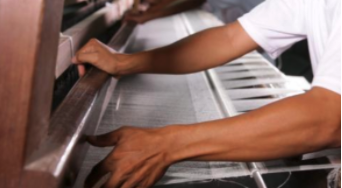FRIDAY AUGUST 2, 2024
MASTERING THE DETAILS: 7 COMMON SPECIFICATION ERRORS TO AVOID

As a designer, you know that beauty lies in the details. At Hartmann&Forbes, we recognize that even the most minor specification errors can lead to significant challenges. To help you achieve flawless installations and satisfied clients, we’ve identified the seven most common specification errors and recommended ways to avoid them in the future.
1. PRIVACY ENHANCEMENTS OFTEN OVERLOOKED1. PRIVACY ENHANCEMENTS OFTEN OVERLOOKED
It's not uncommon for clients to overlook specifying privacy upgrades when ordering shades. While our natural weaves are visually stunning, they may not provide sufficient privacy or room-darkening capabilities by default.
RECOMMENDATION: For areas such as bedrooms or spaces where light control is crucial, consider this aspect during the initial specification. We offer three effective solutions for enhanced privacy and sun control: privacy liners, independent dual shades, or extra-density weaving. Refer to p.64 of the Style Guide or this PDF for details (must be logged in).
2. ROMAN SHADE CLUTCH DAMAGE FROM MISUSE2. ROMAN SHADE CLUTCH DAMAGE FROM MISUSE
Our Legacy Clutch system is highly effective across numerous applications but requires careful handling due to its delicate spear mechanism. Frequent issues arise when users forcefully pull the shades, attempting to tuck the Roman folds under a valance — an action that exceeds the design limits due to the folds’ length.
RECOMMENDATION: For high-usage areas or where users might not be familiar with a clutch system, consider opting for our Ultra Clutch system, which features a more robust tube mechanism, or upgrade to the Newton motor system for a superior user experience.
3. ISSUES WITH SHADE MEASUREMENT3. ISSUES WITH SHADE MEASUREMENT
Many returned shades require resizing due to inaccurate initial measurements, leading to delays since each shade is custom-handwoven to precise dimensions.
RECOMMENDATION: While our measuring guide is available at hartmannforbes.com, we strongly advise that these measurements serve only as estimates. Always employ a professional installer to ensure accurate measurements for final orders.
4. ROMAN SHADE CONFIGURATION UPDATES4. ROMAN SHADE CONFIGURATION UPDATES
Shades are often returned for conversion to a Splitview Style configuration to address privacy concerns, especially in homes with compromising window placements.
RECOMMENDATION: In privacy-sensitive areas like bathrooms and bedrooms, consider specifying a Splitview Style configuration when initially specifying.
5. REQUESTS FOR POST-PURCHASE MOTORIZATION5. REQUESTS FOR POST-PURCHASE MOTORIZATION
Motorized shades significantly enhance the user experience, providing ease of use and a touch of sophistication. Once clients experience the difference, they commonly request motorization after initially opting for manual shades.
RECOMMENDATION: Always discuss the budget thoroughly with clients, helping them understand the long-term value and daily benefits of investing in a motorized system.
6. ADJUSTING SIDE RETURNS6. ADJUSTING SIDE RETURNS
Side returns on outside mount shades are essential for concealing the hardware when viewed from the side. As shade operation technologies evolve and become bulkier, the need for appropriate side returns becomes more pronounced.
RECOMMENDATION: We generally recommend the shortest possible side return. However, the larger the operation method chosen, the more critical it becomes to review and adjust the side returns before placing an order. Consider a structured valance, removing the standard valance, and installing the shade within the valance framework for a seamless look, especially when opting for Newton or automation.
7. INTERIOR LIGHTING CONSIDERATIONS7. INTERIOR LIGHTING CONSIDERATIONS
The use of direct interior front-lighting or accent/spot-lighting on natural shades is strongly discouraged. These artificial interior lighting methods can overshadow the subtle, intricate textures that define the artistry of our craftsmanship. Such lighting can also distort the appearance of our handwoven, natural materials, drawing unwanted attention to inherent, organic surface variations, such as rippling or wrinkling.
RECOMMENDATION: If the use of direct front lighting or accent lighting on the shades is unavoidable, selecting a more heavily-textured weave can help minimize the appearance of any organic surface variations. Please be aware, however, that challenges that may arise specific to the use of artificial interior lighting fall outside the scope of our craftsmanship warranty.
---
By addressing these common specification errors, you can ensure a smoother process, leading to higher client satisfaction and fewer post-installation issues. For more detailed guidance, please refer to our comprehensive Style Guide or contact our support team directly.




